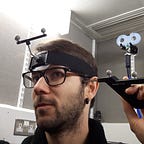2021 Haptic Devices Landscape
What is haptics?
Haptics is a multidisciplinary research field dealing with our sense of touch. It spans from philosophy to robotics and, therefore, it requires a multifaceted expertise to engineer compelling haptic experiences.
In order to create a haptic device, we need to understand the following:
- How our skin senses the touch. There are four mechanoreceptors, pain and temperature receptors in skin, receptors in tendons, muscle spindles, C-afferents in hairy skin etc. They encode the touch and proprioceptive information.
- How we perceive the touch. The signal from receptors travels to our spine where the first crosstalk between neurons happens, then it continues into the thalamus and then to the sensorimotor cortex (above our ears). All of these places create complex network of sensations that lets us understand where in space we are, feel our loved ones, protect ourselves from excessive pain, take a match out of a match box and tickle.
- How to engineer haptic actuators enabling variety of haptic sensations. These are the basis for kinaesthetic devices (force-feedback robotic systems and exoskeletons) cutaneous devices (sensations in the skin, such as microfluidics), as well as enable direct activation of mechanoreceptors or muscles by using electrical stimulation. The cutaneous actuators can provide vibrational signals, force signals, move tiny pins and bubbles or change friction locally (to imitate different textures).
- Form a control system that would couple the movement of our body parts (finger, arm and body tracking), with visual representation of the physical world and with those haptic sensations. This can lead to an accurate representation of the virtual haptic world (most complex and expensive) or, while reducing realism, the correct design can reduce the price and complexity, and bring compelling and consistent haptic and pseudo-haptic experiences which will enable a deeper level of immersion.
All this multitude of potential approaches has led to development of a wide variety of dramatically different devices. They address different use cases, body parts, levels of realism and price points. Below you can see the landscape of the haptic devices split by technology.
Haptic devices landscape
Disclaimer. The companies presented here have their products either commercially available, in the forms of development kits or very close to commercial launch. The old devices that either were not updated in the last 2+ years or are discontinued (such as CyberGlove, GloveOne etc) are not presented here. The university studies, although very broad, are not represented in this table too. For a thorough review on the haptic technology from the best global university research groups, please refer to this paper by Culbertson, Schorr and Okamura.
I have omitted the technology providers and licensors, such as Immersion, Interhaptics, NanoPort, AAC, Alps etc.
Please let us know, if we have missed anything important.
